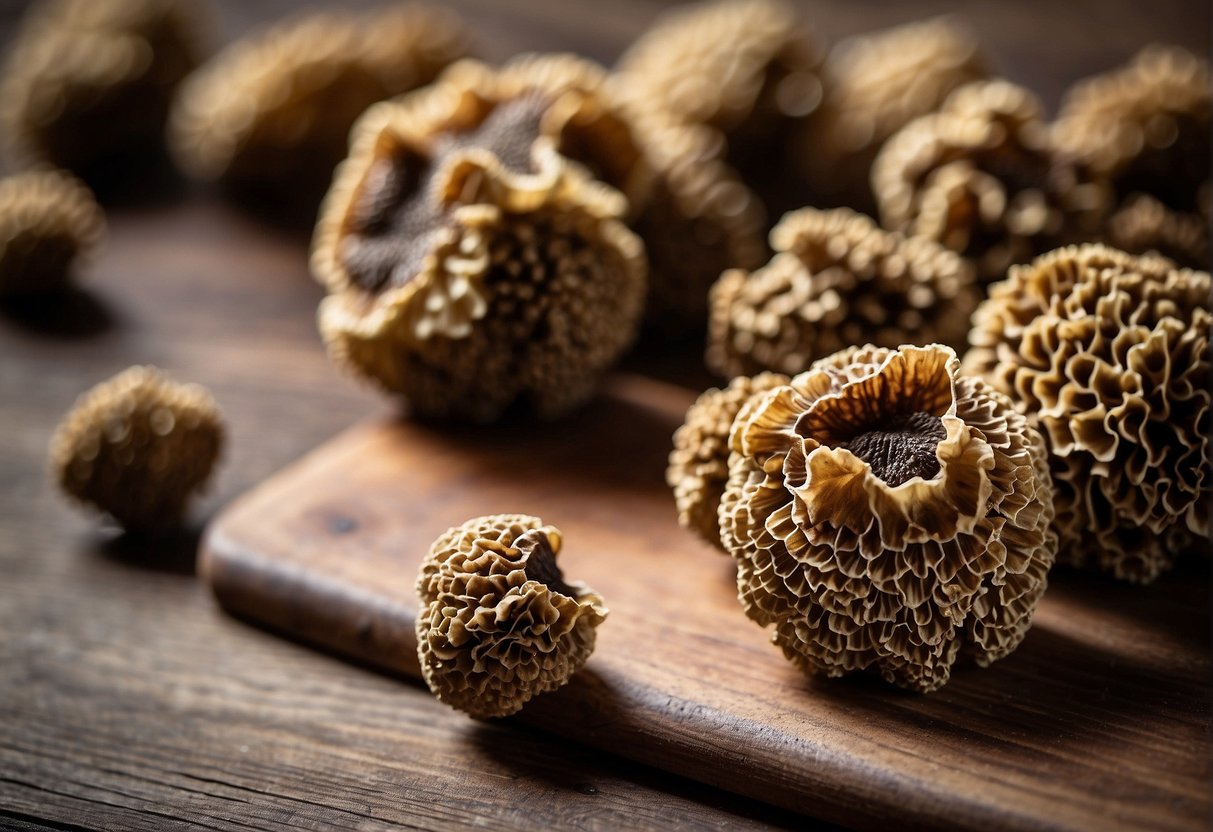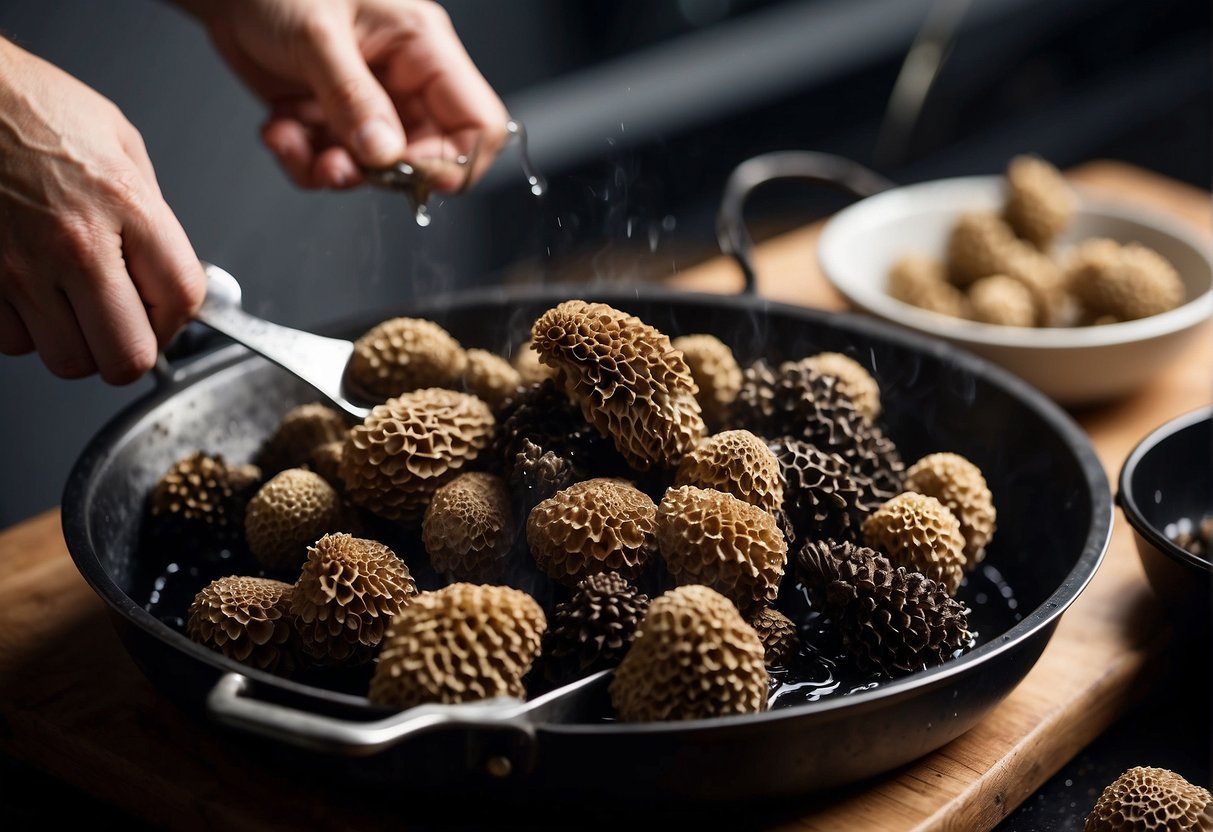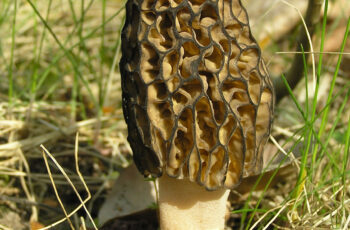Dehydrated morel mushrooms provide a fantastic way to preserve the bounty of your foraging. Morels, highly sought after for their earthy flavor and unique texture, can be elusive and have a short mushroom season. By dehydrating them, you can extend the shelf life of these prized fungal treasures and enjoy their distinctive taste year-round.

If you’re an outdoors enthusiast who enjoys mushroom hunting, you’re aware that morels appear in the wild for only a few weeks each year. Dehydration is an effective method to ensure none of your hard-earned haul goes to waste. The process locks in the flavors and makes for lightweight, easily stored, and conveniently transportable food, perfect for adventurers on the move.
When you prepare your morels for dehydration, it’s important to wash them carefully to get rid of any dirt and debris. Gentle handling is essential to maintain the integrity of the mushrooms. Once cleaned and patted dry, slicing your morels in half can help achieve more even drying. A dehydrator set to a moderate temperature can turn your fresh fungi into a shelf-stable form without sacrificing taste or nutritional value.
Preparing Morels for Dehydration
Before you start the dehydration process, it’s crucial to clean and prepare your morel mushrooms properly. This ensures the final dried product is of the highest quality.
Cleaning and Slicing
1. Washing:
Firstly, fill a bowl with cold water and gently place your morels in it. Carefully swish them around to loosen any dirt or debris. Morels are often nestled in the forest, so they collect a fair bit of nature’s residue.
- Quick Rinse: After the initial soak, give them a quick, yet thorough, rinse under running cold water.
- Pat Dry: With a paper towel, pat the mushrooms dry. This step is vital as any excess moisture can affect the dehydration process.
2. Slicing:
Once clean, lay the morel on its side and slice it lengthwise. Cleaning them properly could mean the difference between preserved bounty and wasted forage.
- In Half: For most morels, slicing them in half is adequate, ensuring even drying.
- Inspection: As you slice, inspect for any remaining debris hidden within the crevices.
Arranging on Trays
1. Dehydrator Preparation:
Preheat your dehydrator to the recommended temperature for mushrooms, generally around 125°F to 135°F.
- Spacing: On the tray, lay out the morel slices in a single layer, maintaining space between them for adequate air flow.
2. Drying:
With the mushrooms positioned well, the actual dehydration can commence. Expect this to take several hours. Keep in mind:
- Consistency: The slices should feel brittle and papery once fully dehydrated.
- Storage: After dehydration, store your morels in a cool, dry place to ensure they retain their earthy essence until you’re ready to enjoy them.
Dehydration Techniques
When preserving morel mushrooms through dehydration, it’s essential to ensure that you maintain the right temperature and air circulation for the best results. Here’s how you can do it using three popular methods.
Using a Food Dehydrator
To dehydrate morel mushrooms using a dehydrator, begin by thoroughly cleaning and slicing the morels evenly. Preheat your dehydrator to a temperature between 125°F to 135°F to achieve the optimal drying environment. Arrange the mushroom slices in a single layer on the dehydrator trays, ensuring there is enough space between each piece for proper air flow. The duration of dehydrating can vary but typically ranges from 4 to 8 hours. Check periodically to ensure they don’t over-dry.
Oven-Drying Morels
While not as precise as a dehydrator, your oven can also be effective for drying morels. Set the oven to its lowest temperature setting, generally between 120°F to 140°F to mimic a dehydrator’s dry heat. Place morels on a baking sheet in a single layer and allow them to dry slowly. Oven-drying can take approximately 8 to 12 hours; keep the oven door slightly ajar to enhance air circulation and check the mushrooms regularly.
Air-Drying Methods
Air-drying morels is a more natural approach that utilizes sunlight and a gentle breeze. You can string the mushrooms and hang them in a dry, well-ventilated area or employ a fan to create a steady air flow around the morels. It’s critical that the area is free from humidity to prevent mold growth. This method can take a few days, depending on the temperature and air circulation.
Storing Dehydrated Morels
Proper storage is key to maintaining the quality and extending the shelf life of your dehydrated morels. Ensure they’re completely dry before storing to prevent mold and spoilage.
Airtight Containers
Utilize airtight containers such as mason jars or glass jars to store your morels. Check that the lids seal tightly to keep moisture and air out, as these could rehydrate the mushrooms and lead to decay. This method is effective for maintaining flavor and texture for future use.
Freezing for Longevity
For extended preservation, consider freezing your dehydrated morels. Place the completely dried mushrooms in vacuum-sealed bags, removing as much air as possible to prevent freezer burn. Properly sealed, dehydrated morels can last in the freezer for well over a year.
Pantry and Cupboard Storage
The pantry or a dark cupboard can be ideal for short-term storage of dehydrated morels provided the area is cool and free of humidity. Store them in a sealed container, away from direct sunlight and any heat sources. This will help maintain their quality and extend their shelf life.
Culinary Uses and Rehydration
Dehydrated morel mushrooms are a treasure in the kitchen, offering a unique combination of earthy flavor and meaty texture that enhances a variety of dishes. When it comes to using them, knowing how to properly rehydrate these dry morels is key to unlocking their full potential in your cooking.

Rehydrating Morels for Cooking
Proper rehydration of dehydrated morel mushrooms is crucial to restore their texture and concentrate their flavors, which are revered in culinary applications. Begin by gently rinsing your dry morels to remove any residual debris. The most effective method involves submerging the mushrooms in warm water, which you can do as follows:
- Place the morels in a bowl large enough to give them space to expand.
- Pour warm water over the morels, ensuring they are fully covered.
- Allow to soak for 20-30 minutes, or until they feel plump and tender to the touch.
During this time, morels will absorb moisture, reconstituting them to a state similar to fresh mushrooms. Keep in mind the liquid left behind is a broth rich in flavor, suitable for use in soups and stews, so consider saving it for later culinary use.
Incorporating Into Dishes
Once your morels are rehydrated, drain the excess water, and pat them dry with parchment paper or a clean baking sheet. This ensures that when you move to sauté the morels, they will brown nicely instead of steaming. Your reconstituted morels can now be integrated into various recipes:
-
Sautéed Morels: Cook them with butter or oil over medium heat until they develop a golden exterior. This brings out a rich, nuanced flavor perfect for pasta dishes and risottos.
-
Soups and Stews: Add your rehydrated morels directly to broths to infuse them with an earthy aroma and deep umami character.
-
Baked Dishes: Incorporate them into casseroles or layer with other ingredients before covering and baking to retain their moisture and tenderness.
Whether you choose to preserve morels by dehydration for future use or acquire them already dried, rehydrating them opens up a realm of culinary possibilities where their distinctive taste and texture can shine, from a simple sauté to more complex recipes. Remember to handle them with care, and you’ll bring a touch of the wild forest straight to your kitchen table.


